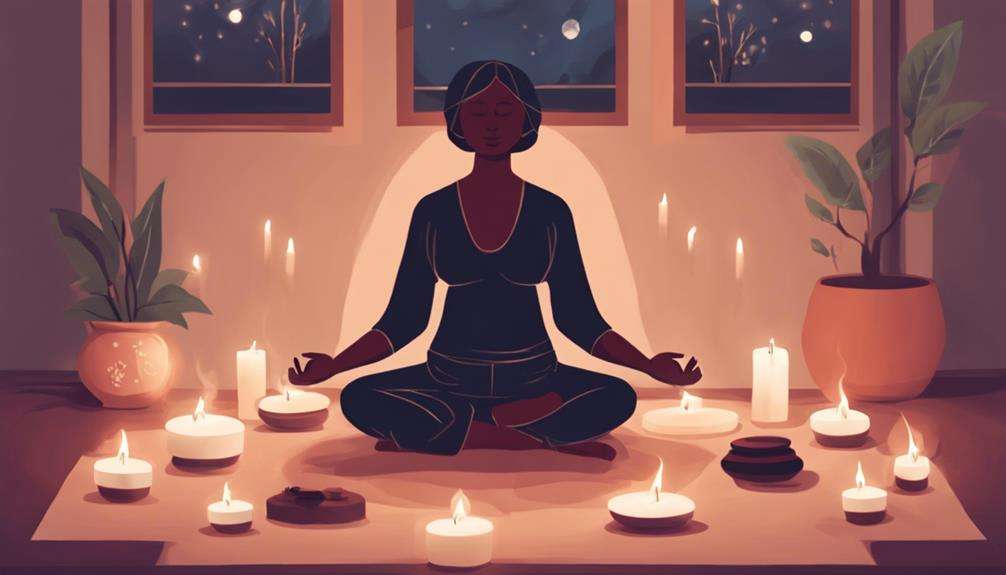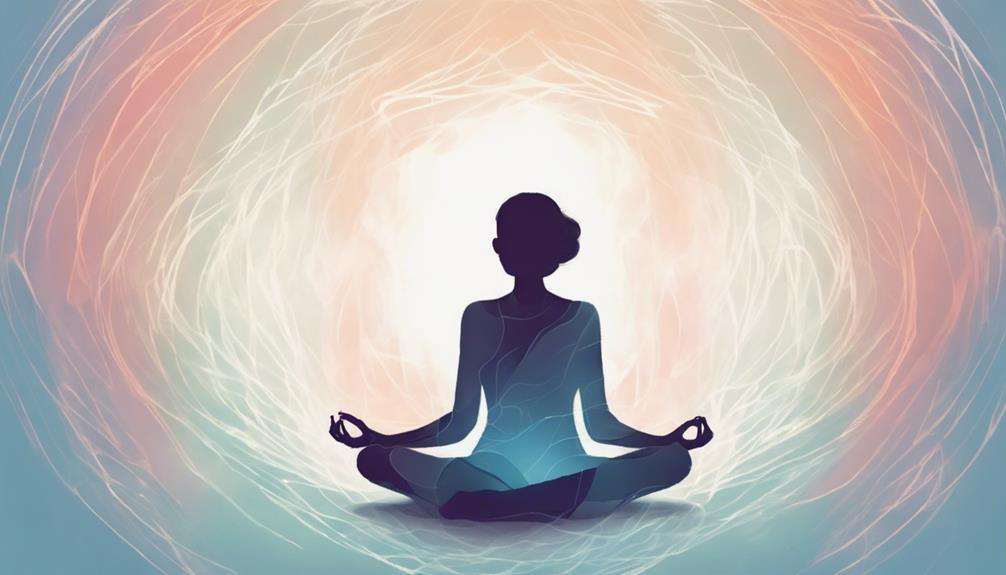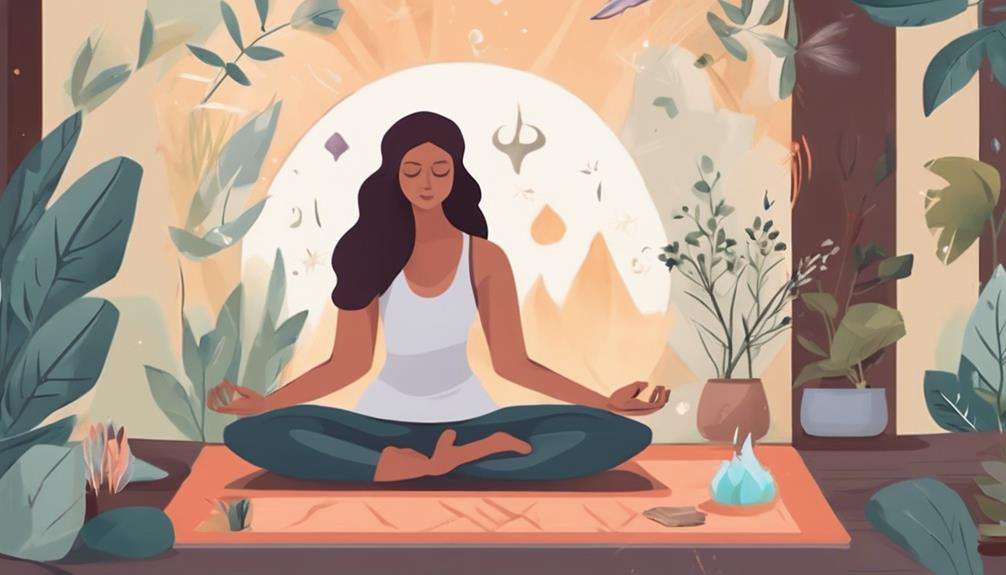When you feel overwhelmed by the stresses of daily life, imagine a scenario where you can effortlessly let go of tension and find calm within yourself.
By exploring various meditation techniques, you can unlock the door to inner peace and serenity.
Discover how simple practices can transform your mindset and lead you on a journey towards a more balanced and harmonious existence.
Key Takeaways
- Practice mindfulness and loving-kindness meditation for enhanced emotional wellbeing and compassion.
- Utilize visualization and nature retreats to create serene mental spaces and connect with the earth.
- Embrace self-love, gratitude, and acceptance through meditation for inner peace and happiness.
- Cultivate mindfulness practices, breath focus, and deep breathing for calmness and emotional stability.
Meditation Techniques for Inner Peace
Discover five powerful meditation techniques that can help you cultivate inner peace and tranquility in your daily life.
Mindfulness practices are essential for nurturing emotional wellbeing and promoting inner peace. By focusing on the present moment without judgment, mindfulness meditation allows you to heighten your awareness and achieve a sense of calmness within.
Incorporating loving-kindness meditation into your routine fosters feelings of compassion and connection towards both yourself and others, contributing to a greater sense of inner peace.
Body scan meditation, which involves systematically scanning your body for sensations, aids in promoting relaxation and mindfulness by bringing attention to each part of your body.
Transcendental meditation utilizes a silent mantra to induce a state of deep relaxation and inner peace.
Lastly, guided visualization meditation guides you through visual imagery to reduce stress, promote relaxation, and ultimately cultivate inner peace. Embrace these meditation techniques to enhance your emotional wellbeing and bring tranquility into your daily life.
Mindfulness Practices for Calmness
To achieve a sense of calmness and inner peace, engage in mindfulness practices that involve focusing on the present moment without judgment or attachment to thoughts or emotions.
Mindfulness meditation techniques, such as breath awareness, body scan, loving-kindness, and walking meditation, can help you cultivate awareness, reduce stress, enhance emotional regulation, and promote inner peace. Regular practice of mindfulness has been linked to improved mental health, reduced anxiety, and increased overall well-being.
By incorporating mindfulness into your daily life, you can experience greater clarity, resilience, and a deeper sense of calmness. Remember that mindfulness isn't about eliminating thoughts or emotions but about observing them without getting caught up in them.
Embrace the present moment during your meditation practice to find peace within yourself and create a more harmonious relationship with the world around you.
Breath Focus for Peaceful Mind

Focusing on your breath during meditation can bring about a peaceful state of mind and reduce stress levels effectively. By centering your attention on the breath, you invite a sense of calm and tranquility into your being. The practice of breath focus is a powerful technique that promotes inner stillness and mental clarity. As you engage in deep breathing exercises, you allow yourself to let go of distractions and connect with the present moment.
Through breath focus, you create a space for relaxation and peace within yourself. Each inhale and exhale guides you towards a state of serenity and emotional balance. The simplicity of focusing on your breath can have profound effects on your overall well-being. By using the breath as a focal point, you enhance your ability to concentrate, cultivate mindfulness, and experience a deeper sense of connection with yourself. Embrace the power of breath focus to nurture your inner peace and foster a harmonious relationship between your body and mind.
Self-Love and Inner Peace Connection
Cultivating self-love through meditation fosters a profound connection with your inner peace, nurturing a positive relationship with yourself. This connection is vital for your emotional well-being and overall sense of tranquility.
Here are four essential ways in which self-love and inner peace are interconnected through meditation techniques:
- Embracing Imperfections: By practicing self-love during meditation, you learn to accept and embrace your imperfections, fostering a deep sense of inner peace.
- Prioritizing Self-Care: Through meditation, you can prioritize self-care practices, recognizing your worth and nurturing inner peace.
- Reducing Self-Criticism: Connecting with yourself through self-love in meditation helps reduce self-criticism and negative self-talk, leading to a more peaceful mindset.
- Building Resilience: Cultivating self-love empowers you to face challenges with resilience and inner harmony, enhancing your overall well-being and peace of mind.
Visualization for Inner Peace

Engage your mind in peaceful visualizations to enhance your inner peace and emotional well-being during meditation.
Visualization is a potent technique that allows you to create mental images of serene scenes or scenarios, aiding in stress reduction and relaxation. By immersing yourself in positive and calming visualizations such as tranquil landscapes or soothing colors, you can deepen your sense of inner peace.
This practice not only fosters a tranquil mindset but also cultivates gratitude, positivity, and tranquility, promoting a profound sense of calmness and clarity within you. Through visualization, you stimulate your imagination, nurture creativity, and establish a stronger connection with your emotions and inner self during meditation.
The peace you generate through visualization can spread to various aspects of your life, fostering a more grounded and serene existence. Embrace this technique to strengthen your inner peace and emotional well-being, allowing yourself to experience profound tranquility and harmony.
Gratitude Practice for Serenity
To enhance your serenity and emotional well-being, consider embracing a gratitude practice in your daily life. Gratitude practice involves expressing thankfulness for the positive aspects of life, which can reduce stress and improve overall well-being.
Keeping a gratitude journal can enhance feelings of serenity and contentment, allowing you to shift your focus from negativity to appreciation of present moments. Cultivating gratitude through regular practice can lead to increased feelings of inner peace and happiness.
By acknowledging and being grateful for the good things in your life, you invite positivity and tranquility into your daily experiences. Incorporating gratitude practice into your routine can help you find peace within yourself and the world around you.
Take a moment each day to reflect on what you're thankful for, and notice how this simple practice can bring a sense of calm and fulfillment to your life.
Nature's Influence on Inner Peace

Spending time in nature can have a profound impact on your inner peace.
The calming effects of natural surroundings, such as serene forests or peaceful nature retreats, can help you find tranquility and relaxation.
Immersing yourself in nature's beauty is a powerful way to reduce stress and promote a sense of calm within yourself.
Calming Effects of Nature
How can immersing yourself in the calming embrace of nature positively impact your inner peace and well-being?
Nature holds a profound ability to soothe your mind, reduce stress, and enhance your mental health. Here's how it works:
- Stress Reduction: Nature's serenity helps lower stress levels, allowing your mind to focus and relax.
- Physical Well-being: Exposure to natural settings can improve your overall mood, lower blood pressure, and boost your mental health.
- Mindfulness Enhancement: Engaging in nature-based activities promotes mindfulness, fostering inner peace and tranquility.
- Recharging Energy: Unplugging from technology and connecting with nature enables you to recharge, find balance, and restore harmony within yourself.
Serenity in Natural Surroundings
Immerse yourself in the gentle embrace of natural surroundings to discover a profound sense of serenity and inner peace. As you focus on the breath in the midst of nature's beauty, allow yourself to let go of any tension or worries weighing on your mind.
The calming effect of nature works wonders in reducing stress and anxiety levels, promoting relaxation that nurtures a peaceful state of being. By connecting with the sights and sounds of the natural world, you can find inner peace and tranquility.
Studies support the idea that spending time in nature enhances well-being and uplifts mood, offering a serene sanctuary for your mind and soul. Embrace the harmony that nature provides and let it guide you towards inner peace.
Peaceful Nature Retreats
Nature retreats offer a serene and nurturing environment that fosters meditation and inner peace. Immerse yourself in the following to enhance your experience:
- Breath: Allow the fresh, clean air of nature to guide your breath, bringing a sense of calm and clarity to your mind.
- Meditation: Find a peaceful spot amidst the trees or by a babbling brook to meditate and center yourself in the present moment.
- Inner Peace: Let the beauty of the natural surroundings soothe your soul, helping you to let go of stress and worries.
- Connection: Feel connected to the earth beneath your feet, fostering a sense of grounding and harmony within yourself.
Embrace the tranquility of nature to deepen your meditation practice and cultivate inner peace.
Acceptance and Inner Peace

Cultivating acceptance through meditation practices is essential for achieving inner peace, allowing you to embrace reality and let go of resistance. By incorporating meditation techniques like mindfulness and loving-kindness meditation into your daily routine, you can reduce stress and anxiety, promoting a sense of calmness within yourself. Inner peace becomes attainable when you practice non-judgment and acceptance towards both yourself and others.
Through the practice of acceptance, you can develop a mindset that fosters emotional well-being and mental clarity. Embracing acceptance leads to a deeper sense of inner peace, helping you navigate life's challenges with a sense of tranquility. As you continue to engage in meditation techniques aimed at cultivating acceptance, you'll find yourself better equipped to handle the ups and downs of life with grace and composure. Remember, acceptance isn't about resignation but rather about acknowledging reality and finding peace within it.
Connecting Deeper for Inner Peace
As you explore the importance of connecting deeper for inner peace, remember that mindfulness practices and breathing techniques can be powerful tools in fostering a sense of calm and tranquility within yourself.
Taking time to focus on your breath and practicing mindfulness can help you cultivate a deeper connection with your inner self, paving the way for increased peace and emotional well-being.
Mindfulness for Peace
Enhancing self-awareness and emotional regulation through mindfulness meditation is key to fostering inner peace and tranquility. By practicing mindfulness daily, you can deepen your connection with yourself and others, promoting harmony and a sense of calm.
Here are some benefits of incorporating mindfulness into your routine:
- Reduced Stress: Mindfulness helps in lowering stress levels by focusing on the present moment.
- Improved Emotional Well-being: Practicing mindfulness leads to better emotional regulation, reducing anxiety and negative emotions.
- Enhanced Present-Moment Awareness: Staying present in the moment with non-judgmental awareness cultivates a peaceful state of mind.
- Increased Contentment: Mindfulness paves the way for inner peace and serenity, fostering a more content and balanced outlook on life.
Breathing Techniques
To deepen your inner peace and connection with yourself, incorporating breathing techniques can be a powerful way to cultivate tranquility and relaxation. Deep breathing techniques are known to calm the mind and body by increasing oxygen flow and reducing stress hormones.
By focusing on your breath, you promote mindfulness and presence, leading to inner peace and relaxation. Controlled breathing not only lowers blood pressure but also improves sleep quality and enhances overall well-being.
Breath awareness techniques can assist in managing anxiety, improving concentration, and fostering emotional stability. Regular practice of rhythmic breathing exercises strengthens the mind-body connection, supporting your journey towards inner peace and a deeper sense of relaxation.
Frequently Asked Questions
How Do You Meditate for Inner Peace?
Focus on your breath, practice mindfulness, and use visualization techniques. Relax with breathing exercises, observe thoughts without judgment, and imagine a peaceful place. Embrace self-love and kindness. Set positive intentions to maintain inner peace.
What Are the 3 Ways on How We Can Have Inner Peace?
To have inner peace, practice mindful breathing for clarity, gratitude for positivity, and loving kindness for connection. Visualize calmness, scan your body for relaxation, and walk in meditation for grounding. Embrace these methods for peace within.
How Do You Go Inside Yourself When Meditating?
Focus on deep breathing, guided visualization, and mindful awareness. Dive within yourself by quieting external noise. Allow stillness to guide you deeper into your being. Find peace and harmony through introspection and self-connection.
How Do You Meditate for Inner Strength?
When meditating for inner strength, start by focusing on mindful breathing to center yourself. Use visualization and mantra repetition to build resilience. Practice body scans to connect with your strength. Embrace loving kindness and gratitude to nurture inner resilience.
Conclusion
As you continue to practice meditation techniques for inner peace, remember that you're like a calm river flowing gracefully through the obstacles of life. Embrace the stillness within you, let go of distractions, and connect with your true self.
With each breath, you cultivate a sense of serenity and balance that radiates outward, bringing peace to your mind, body, and spirit. Keep meditating, keep growing, and keep finding peace within.






